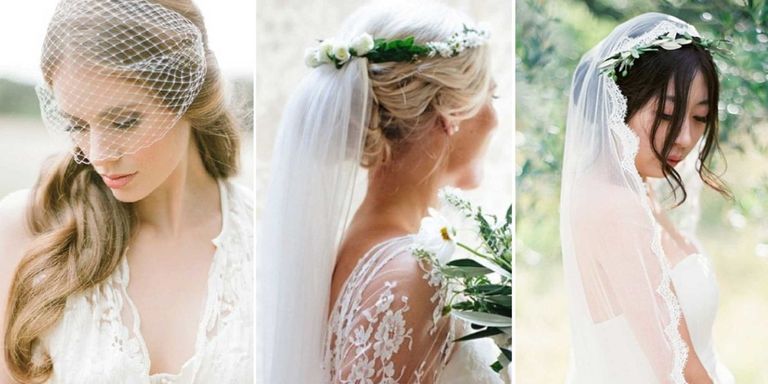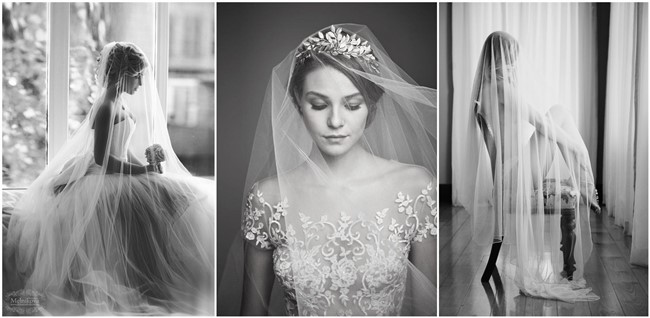Wedding veils are an iconic bridal accessory, but with so many different styles, details and lengths to choose from, how are you supposed to know which one’s right for you and your wedding day outfit? Fingertip, chapel or mantilla - the options are endless. Follow these handy tips from The Knot to choose the perfect veil to top off your look!
Start With the Length
To find the ideal veil to match your wedding style, first consider length. Test out a variety of options when you go for your first dress fitting to see what length works best with your gown. That means finding a style that complements your overall silhouette—you don't want your veil to interrupt the flow of your look. Designers will often make veils tailored specifically for their dresses, so you can use these as a starting point. Shorter veils, like bandeaus, birdcages and blushers, tend to lend a bit more personality as well as an informal or retro edge to your look, while longer veils (ballet, chapel and cathedral styles) lean more in the way of tradition and formality. If you can't find one you love, you can always go the custom route. Many companies will create a veil to your specifications, from the length to the color and the kind of embellishments.
Choose a Complementary Color
Aim to match the color of the veil to your wedding gown as closely as you can. And since photos may not accurately portray the correct color, bring a swatch of fabric from your dress when you go veil shopping. The one exception to this rule is antique veils—you shouldn't try dying a vintage veil (it's not worth the risk of ruining such a delicate piece). As long as the colors are close enough don't worry if they're not a 100 percent match—the appeal of an heirloom style is in its uniqueness and sentimentality (if it was your mom's or grandmother's, for instance), so it won't matter if it's slightly off in color.
Strike the Right Balance With Embellishments
If your wedding dress is heavily embellished, keep your veil on the clean and simple side, with minimal (if any) extras. And vice versa: A simple, streamlined gown allows you to be a bit more adventurous in the veil department. Play around with unexpected shapes, accents and textures, like a floral-embellished chapel-length veil, a lace cap or a couture-inspired bubble veil with over-the-top volume. Try to create a balance as well when it comes to the type of embellishments—while they don't have to match the ones on your dress exactly, they should complement them in color, size and style. A glam sequined veil, for instance, might feel out of place next to a romantic gown embroidered with tiny pearls.
Find the Perfect Fabric
You can't go wrong with tulle—it's a classic choice for veils—but depending on the look you're after, there are also a variety of other materials to consider, such as lace, silk and satin. In most cases, tulle is the most budget-friendly option, and it offers a few benefits over pricier fabrics. Synthetic materials like tulle tend to keep their shape better and have a lighter, more ethereal look than silk and satin, which are more likely to appear heavy and hang straight.
Don't Forget About Your Hair
Before you decide on a veil, it's smart to have some idea how you'll wear your hair on your wedding day—the style you choose may affect your final veil decision. For example, halo veils, bridal caps and mantilla veils work best when hair is worn down or in low updos, while blushers and birdcages are much more versatile and can be worn with most hairstyles. Your hairstyle might also affect where you place the veil and how you secure it. If you're wearing your hair up, you can wear the veil above or below a bun or chignon. Pinning it above gives it more volume and achieves a more classic look, while placing it below feels more modern and keeps the focus on your stylish updo. Once you've purchased your veil, don't forget to take it (along with any other hair accessories you plan to wear) to your hair trial appointments, so you and your stylist can find the perfect 'do (and there won't be any last-minute surprises).
Make Removal Easy on Yourself (and Your Wedding Party)
If you plan to remove your veil after the ceremony (or at any point, really), but want to leave your headpiece on for the reception, attach your veil with fabric hook and loop closures for easy on and off. Keep in mind if you remove your veil before the reception, it won't appear in pictures of the first dance or the cake cutting. If you choose a cathedral, chapel or ballet veil and want to keep it on postceremony, try a multilayered version with a fingertip-length top layer. That way, you can detach the floor-length layers and keep that classic bridal look—but you'll be able to mingle and dance with ease.
The options are endless but with these helpful tips from The Knot, you'll have yours in no time! Start your search today and devour the details of finding your perfect veil!


No comments:
Post a Comment